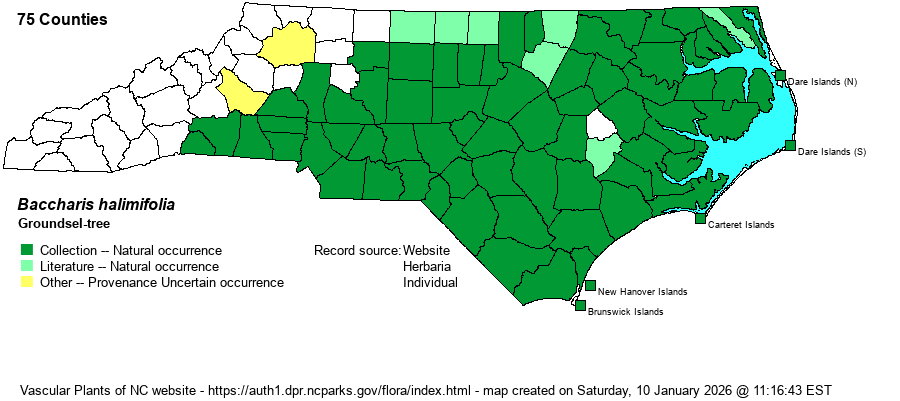| Author | L. | |
| Distribution | The native distribution was apparently just the lower Coastal Plain, mainly in maritime/estuarine habitats. However, it has greatly expanded its range into more ruderal habitats far inland. Now it occurs over the entire Coastal Plain and the eastern and southern 60% of the Piedmont, and now rarely into the upper Piedmont. Weakley (2024) considers it as native onto to the Coastal Plain, and as exotic in the Piedmont and Mountains. However, as the species seemingly has moved inland on its own, the editors for now do not care to consider it as non-native/exotic in these regions (i.e., it might be a matter of semantics).
The present-day range extends from eastern MA though the Coastal Plain and much of the Piedmont south to southern FL, the Gulf Coast, and eastern TX. It has not yet been found in the Midwestern states, WV, or KY.
| |
| Abundance | Currently it is abundant in estuarine habitats, and very common to often abundant elsewhere in the Coastal Plain, such as along roadsides and in disturbed places such as damp thickets. It is common to very common in the eastern Piedmont, but less numerous westward. | |
| Habitat | Most common around margins of brackish marshes and maritime wetlands. However, now widely found along damp roadsides, ditches, weedy fields, vacant lots, and other disturbed sites. It is certainly not restricted to wetlands over its range now. |
| Phenology | Blooms and fruits in September and October, with the abundant fluffy white clusters of seeds quickly following the pale yellow flowering. Most people fail to recognize that the white clusters on the plants are the fruiting bodies, as opposed to flowers. | |
| Identification | This is an evergreen to tardily deciduous, fairly bushy shrub that grows to about 8-10 feet high and wide. It has wedge-shaped glaucous, pale green leaves with scattered teeth toward the apex. It is normally easily identified just by its pale green and wedge-shaped leaves. However, in October these shrubs are festooned with an abundance of the fluffy white fruiting clusters along the branch tips, and not in the leaf axils along the stem. The rare B. glomuliflora has flower clusters scattered in axils along the stems. | |
| Taxonomic Comments | None
| |
| Other Common Name(s) | Groundsel-bush, Sea-myrtle, Eastern Baccharis, Salt Marsh Elder, Saltbush, and several others. It is too bad that the three Baccharis species in the state do not have a group (genus) name that ties the species together. Each has a somewhat quirky name. | |
| State Rank | S5 | |
| Global Rank | G5 | |
| State Status | | |
| US Status | | |
| USACE-agcp | FAC link |
| USACE-emp | FACW link |

